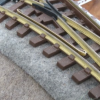Lez2000
Registered
Hello all, I have a problem with a set of LGB 18150 points (radius 5, left hand manual point) in that any loco attempting to cross it is derailed. I've tried various weight locos and they all come to grief.
I've removed the offending points from the layout to have a closer look and found that the wheel flanges are 'bottoming out' when crossing the frog. The problem is worse when travelling from left

to right. The biggest culprit is the mainline and to a lesser extent the turning. Before I strip it down does anyone have a cure or suggestion for this? The points are only a week or so old and purchased new. I really didn't expect this from LGB.
I've removed the offending points from the layout to have a closer look and found that the wheel flanges are 'bottoming out' when crossing the frog. The problem is worse when travelling from left

to right. The biggest culprit is the mainline and to a lesser extent the turning. Before I strip it down does anyone have a cure or suggestion for this? The points are only a week or so old and purchased new. I really didn't expect this from LGB.


